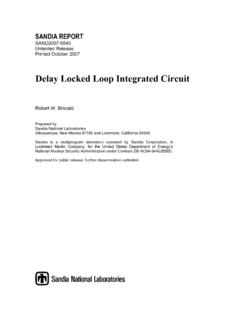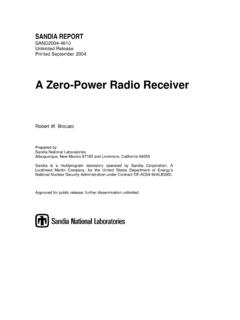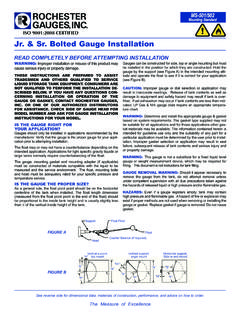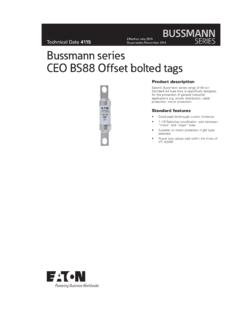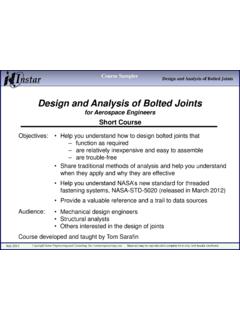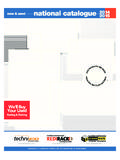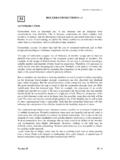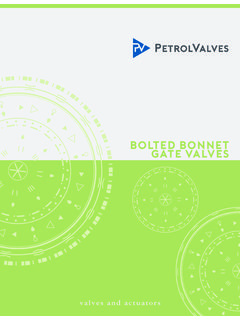Transcription of Guideline for Bolted Joint Design and Analysis: …
1 SANDIA REPORT. SAND2008-0371. Unlimited Release Printed January 2008. Guideline for Bolted Joint Design and Analysis: Version Kevin H. Brown, Charles Morrow, Samuel Durbin, and Allen Baca Prepared by Sandia National Laboratories Albuquerque, New Mexico 87185 and Livermore, California 94550. Sandia is a multiprogram laboratory operated by Sandia Corporation, a Lockheed Martin Company, for the United States Department of Energy's National Nuclear Security Administration under Contract DE-AC04-94AL85000. Approved for public release; further dissemination unlimited. Issued by Sandia National Laboratories, operated for the United States Department of Energy by Sandia Corporation. NOTICE: This report was prepared as an account of work sponsored by an agency of the United States Government. Neither the United States Government, nor any agency thereof, nor any of their employees, nor any of their contractors, subcontractors, or their employees, make any warranty, express or implied, or assume any legal liability or responsibility for the accuracy, completeness, or usefulness of any information, apparatus, product, or process disclosed, or represent that its use would not infringe privately owned rights.
2 Reference herein to any specific commercial product, process, or service by trade name, trademark, manufacturer, or otherwise, does not necessarily constitute or imply its endorsement, recommendation, or favoring by the United States Government, any agency thereof, or any of their contractors or subcontractors. The views and opinions expressed herein do not necessarily state or reflect those of the United States Government, any agency thereof, or any of their contractors. Printed in the United States of America. This report has been reproduced directly from the best available copy. Available to DOE and DOE contractors from Department of Energy Office of Scientific and Technical Information Box 62. Oak Ridge, TN 37831. Telephone: (865) 576-8401. Facsimile: (865) 576-5728. E-Mail: Online ordering: Available to the public from Department of Commerce National Technical Information Service 5285 Port Royal Rd. Springfield, VA 22161. Telephone: (800) 553-6847.
3 Facsimile: (703) 605-6900. E-Mail: Online order: #online 2. SAND2008-0371. Unlimited Release Printed January 2008. Guideline for Bolted Joint Design and Analysis: Version Version , January 2008. Kevin H. Brown, Charles Morrow, Samuel Durbin, and Allen Baca Box 5800, MS0501. Sandia National Laboratories Albuquerque, NM 87185. ABSTRACT. This document provides general guidance for the Design and analysis of Bolted Joint connections. An overview of the current methods used to analyze Bolted Joint connections is given. Several methods for the Design and analysis of Bolted Joint connections are presented. Guidance is provided for general Bolted Joint Design , computation of preload uncertainty and preload loss, and the calculation of the Bolted Joint factor of safety. Axial loads, shear loads, thermal loads, and thread tear out are used in factor of safety calculations. Additionally, limited guidance is provided for fatigue considerations. An overview of an associated Mathcad Worksheet containing all Bolted Joint Design formulae presented is also provided.
4 3. 4. TABLE OF CONTENTS. 1 7. 2 7. Variables 7. 3 General 11. 4 Bolt Preload .. 12. 5 Analytic Modeling Approaches .. 14. Cylindrical Stress Field Method (Q Factor).. 14. Shigley's Frustum Approach .. 18. FEA Based Empirical Approaches .. 20. Edge Effects .. 22. Comparison of the Analytic Methods .. 22. Recommendations for Analytic Approaches .. 25. 6 Partitioning Axial Tensile Load Between the Joint and the 26. 7 Thermal Loads .. 27. 8 Thread Tear 28. Equal Tensile Strength Internal and External Threads .. 28. Higher Tensile Strength Bolt .. 29. 9 Additional 30. Bending Loads .. 30. Torsional Loads .. 30. 31. 10 Finite Element 32. Linear Elastic Analysis .. 32. Non-Linear 33. 11 Combining Loads And Factor of Safety Calculations .. 33. 12 34. Appendix A: Nut Factors .. 37. Appendix B: Mathcad Sheet for Bolted Joint 39. Appendix C: Example Problem .. 43. 5. TABLE OF FIGURES. Figure 1. Joint Nomenclature .. 10. Figure 2. Threaded Joint Geometry .. 11. Figure 3.
5 Q Factor Stress Distribution for 2 15. Figure 4. Q factors for Various Geometries Using the Bickford Method.. 18. Figure 5. Shigley's Stress 19. Figure 6. DMP 21. Figure 7. Comparison of Equivalent Q-Factors for the Various Methods with One 22. Figure 8. Comparison of Member Stiffness for Two Materials and l/d= .. 24. Figure 9. Comparison of Member Stiffness for Two Materials and l/d= .. 24. Figure 10. Comparison of Shigley & Durbin With Two Equal Thickness Materials (n= ) .. 25. 6. 1 INTRODUCTION. The purpose of this report is to document the current state of the art in Bolted Joint Design and analysis and to provide guidance to engineers designing and analyzing Bolted connections. There is no one right answer or way to approach all the cases. In many cases, additional work will be needed to assess the quality of current practices and provide guidance. General information, suggestions, and guidelines are provided here but ultimately the engineer must use his/her judgment on which approach is applicable and the level of detailed analysis required.
6 The basic philosophy is to use a staged approach. The first stage is based on idealized models to provide an initial estimate useful for Design . If the Joint is simple enough and the margins are large enough, this may be all that is required. In contrast, a complicated Joint or one with small margins may require additional analysis. This can range from a relatively simple axisymmetric linear elastic finite element model to a fully nonlinear three dimensional finite element model incorporating geometric nonlinearities and frictional contact. For version of this document, the primary focus is on how to evaluate factors of safety for a single bolt of a Bolted Joint once the axial and shear loads on it are known. The load can be obtained from either analytic models or finite element analyses. Analytic methods for determining the loads on a given bolt of a Joint can be found in Shigley [16] or other mechanical engineering texts. 2 NOMENCLATURE. This section provides a comprehensive list of symbols used in equations and figures in subsequent sections.
7 Section contains two tables, one for variables defined using the standard alphabet and a second table for variables defined using the Greek alphabet. Variables Menu The following two tables list variables used throughout this document. The column listing units is intended to provide the user with guidance regarding units. Units are given in terms of length (L), force (F), radians (rad) and temperature (T). nd is used to denote non-dimensional quantities. Any consistent set of units may be used. Where possible, the description identifies a figure or equation that further defines the parameter. Subscripts not specifically identified in these tables will be addressed during discussions in the appropriate text. 7. Table 1: List of Symbols Symbol Units Description A L2 General symbol for area Ab L2 Area of bolt cross-section. At Tensile Area of a bolt used for thread tear out calculations (See Section ). C nd Integrated Joint stiffness constant. (Equation 26).
8 DB L Equivalent diameter of torque bearing surfaces (Equation 53). d2 L Effective diameter of internal (nut) threads db L Nominal bolt diameter and externally threaded material (bolt) major diameter for thread tear out (Figure 2). dbmm L Externally threaded material (bolt) minimum major diameter dbmp L Externally threaded material (bolt) minimum pitch diameter (Figure 2). dc L Diameter of the clearance hole(s) (Figure 1). Physically, this parameter could be different for every clamped layer but for the equations presented in this document, it is assumed to be the same value for all layers. dh L Diameter of the load bearing area between the bolt head and the clamped material (Figure 1). Dc L The effective diameter of an assumed cylindrical stress geometry in the clamped material. Used in Pulling's method (Equation 13). Dj L Diameter of a Bolted Joint . Used in Bickford method dmt L Internally threaded material (nut) maximum minor diameter (Figure 2). dt L Internally threaded material (nut) maximum pitch diameter (Figure 2).
9 E F/L2 General symbol for Young's modulus of a material. Unless identified below, subscripts will be identified in the text. Eb F/L2 Young's modulus for bolt material Eeff F/L2 Effective Young's modulus for a clamped stack consisting of multiple materials Els F/L2 Young's modulus for the less stiff (ls) material in a two material Bolted Joint . Ems F/L2 Young's modulus for the more stiff (ms) material in a two material Bolted Joint . F F The external axial load applied to separate clamped materials Fb F That portion of F taken up by the bolt Fm F That portion of F taken up by the clamped material FOS nd Factor of safety Fp F Bolt preload Fpr F Bolt proof load. This is the manufacturer specified axial load the bolt must withstand without permanent set. I L4 Moment of inertia Je nd Factor used in the computation of thread tear out K nd Nut factor. (Equation 1). Ke L Length of engaged threads needed to avoid tear-out in using high tensile 8. Symbol Units Description strength bolts k F/L General symbol for stiffness of a bolt, clamped material or overall Joint .
10 Unless identified below, subscripts will be identified in the text. kb F/L Stiffness of the bolt kj F/L Stiffness of the Joint km F/L Stiffness of the clamped material Li L Length of individual component in a Bolted Joint . Le L Minimum length of engagement of a threaded Joint to prevent thread tear out l L Thickness of clamped material. Also used as the length of bolt in the Joint . lett L Effective length of engagement between a bolt and a tapped threaded material (as opposed to a nut). lls L Thickness of the less stiff (lower Young's modulus) clamped material lms L Thickness of the more stiff (higher Young's modulus) clamped material MOS nd Margin of safety N nd Ratio of length of less stiff material to total length of the Joint (Equation 21). ni nd Number of cycles a Joint experiences at the ith stress level Ni nd Expected cycles to failure at the ith stress level P L Thread Pitch (Figure 2). Q nd Ratio of of an assumed cylindrical stress field to the bolt diameter (typically db).

